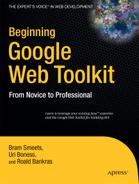Book Description
The open source, lightweight Google Web Toolkit (GWT) is a framework that allows Java developers to build rich Internet applications (RIAs), more recently called Ajax applications, in Java. Typically, writing these applications requires a lot of JavaScript development. However, Java and JavaScript are very distinctively different languages (although the name suggests otherwise), therefore requiring a different development process.
In Beginning Google Web Toolkit: From Novice to Professional, you'll learn to build rich, user-friendly web applications using a popular Java-based Ajax web framework, the Google Web Toolkit. The authors will guide you through the complete development of a GWT front-end application with a no-nonsense, down-to-earth approach.
You'll start with the first steps of working with GWT and learn to understand the concepts and consequences of building this kind of application. During the course of the book, all the key aspects of GWT are tackled pragmatically, as you're using them to build a real-world sample application. Unlike many other books, the inner workings of GWT and other unnecessary details are shelved, so you can focus on the stuff that really matters when developing GWT applications.
Book Description
The open source, lightweight Google Web Toolkit (GWT) is a framework that allows Java developers to build rich Internet applications (RIAs), more recently called Ajax applications, in Java. Typically, writing these applications requires a lot of JavaScript development. However, Java and JavaScript are very distinctively different languages (although the name suggests otherwise), therefore requiring a different development process.
In Beginning Google Web Toolkit: From Novice to Professional, you'll learn to build rich, user-friendly web applications using a popular Java-based Ajax web framework, the Google Web Toolkit. The authors will guide you through the complete development of a GWT front-end application with a no-nonsense, down-to-earth approach.
You'll start with the first steps of working with GWT and learn to understand the concepts and consequences of building this kind of application. During the course of the book, all the key aspects of GWT are tackled pragmatically, as you're using them to build a real-world sample application. Unlike many other books, the inner workings of GWT and other unnecessary details are shelved, so you can focus on the stuff that really matters when developing GWT applications.
Table of Contents
- Copyright
- About the Authors
- About the Technical Reviewer
- Acknowledgments
- Introduction
- 1. Introducing Rich Internet Applications (RIAs)
- 2. Introducing Google Web Toolkit (GWT)
- 3. Getting Started
- 4. GWT UI Components
- 5. Building an Advanced UI
- 6. Server Integration
- 7. Testing GWT Applications
- 8. Advanced Topics
- A. IDE Support
- B. Resources
